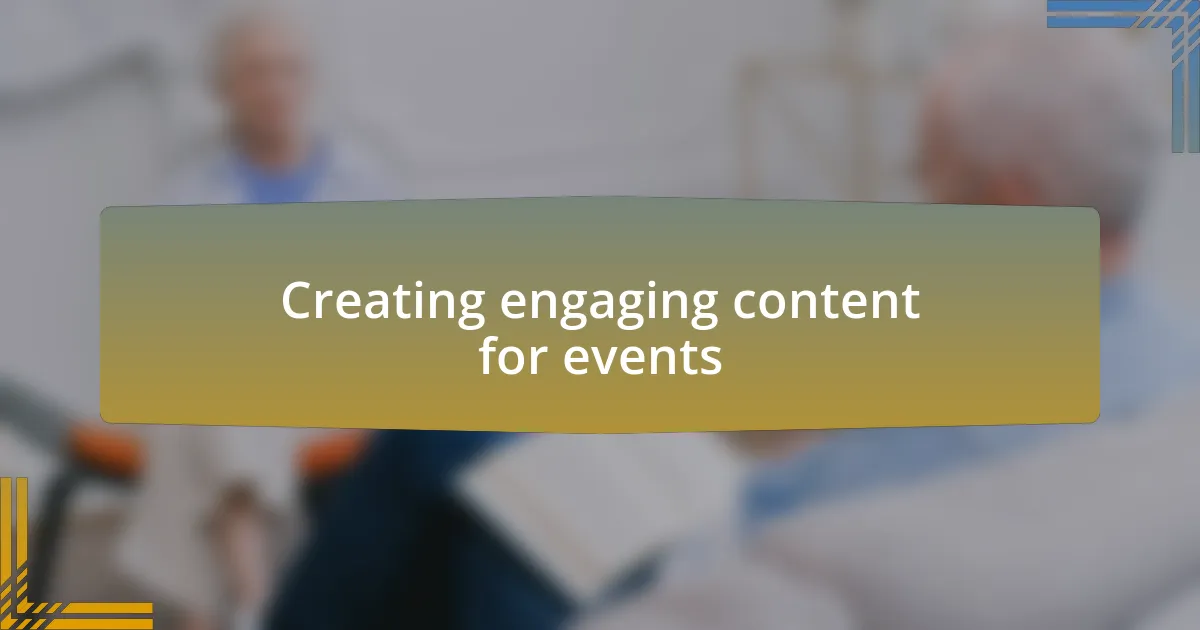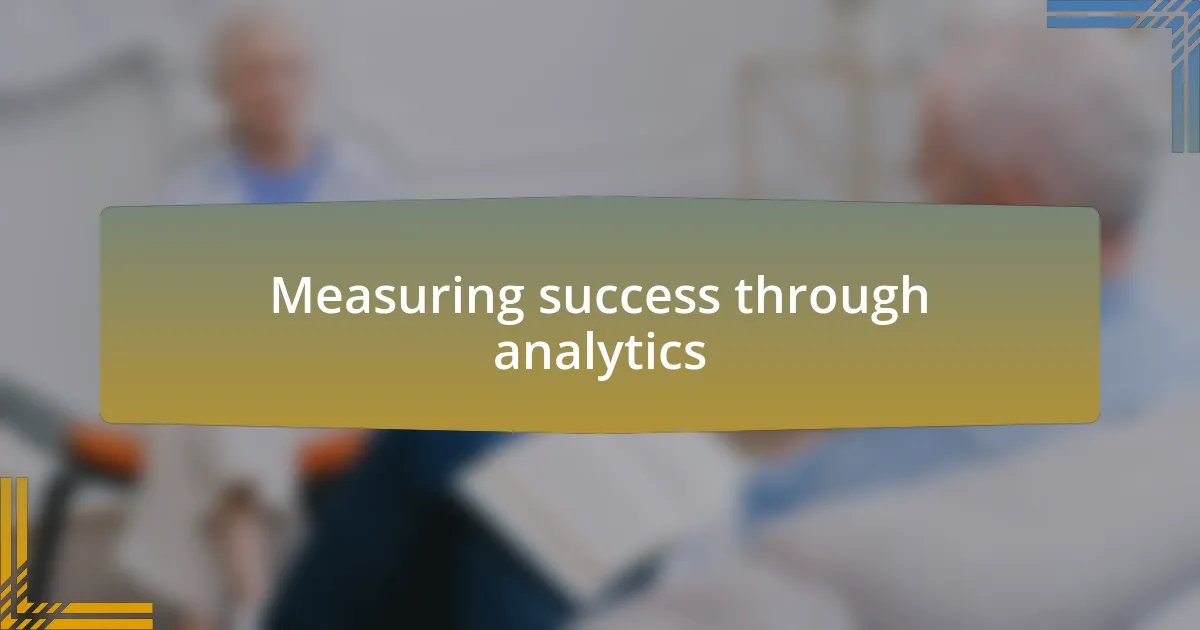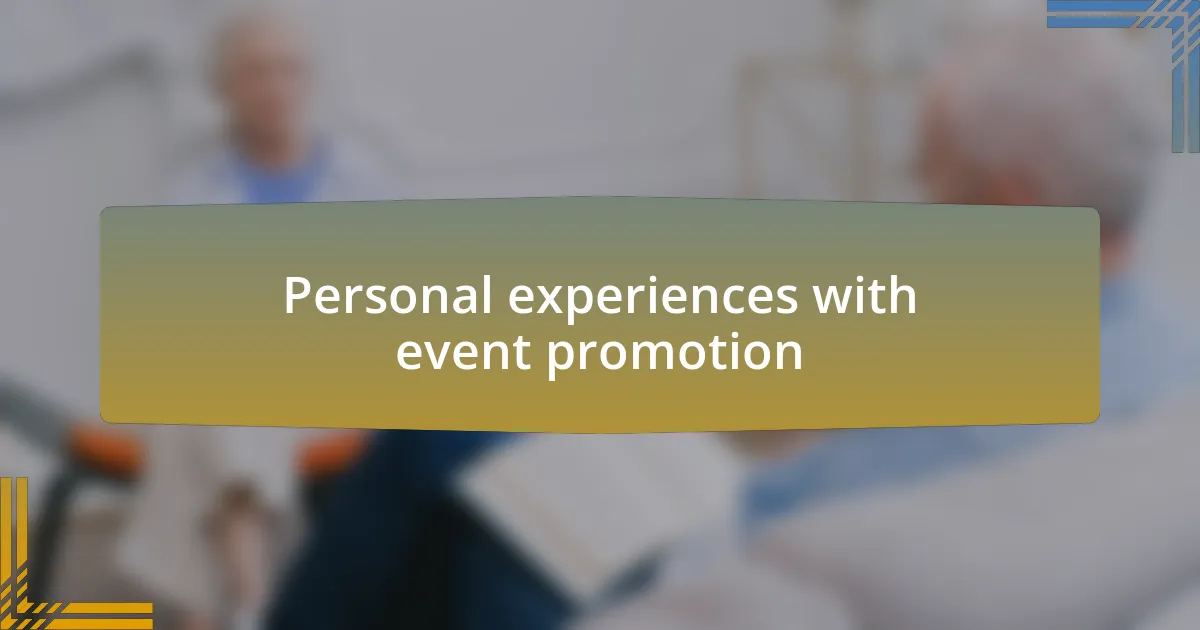Key takeaways:
- Luxury retirement homes focus on comfort, personalized care, and enriching community experiences that enhance residents’ quality of life.
- Social media marketing is essential for promoting these communities, allowing for authentic connections and real-time interactions with potential residents.
- Engaging content and storytelling are key to successful event promotion, fostering a sense of community and anticipation among residents and prospects.
- Analytics are critical for measuring the success of marketing efforts and understanding audience preferences, helping to tailor future events effectively.

Understanding luxury retirement homes
When I think about luxury retirement homes, I immediately picture a blend of comfort and elegance, where residents can enjoy their golden years in style. It’s not just about the plush surroundings; it’s also about the services and community that cater to a sophisticated lifestyle. Have you ever considered how these elements might influence a person’s day-to-day happiness?
The amenities offered can be astonishing. I recall visiting a luxury retirement home with a world-class spa, complete with wellness programs tailored to individual needs. Residents weren’t just enjoying luxurious treatments; they were also participating in enriching activities that promoted mental and physical well-being. Isn’t it fascinating to see how such environments can foster friendships and a sense of belonging?
Another aspect that often gets overlooked is the emphasis on personalized care. One of my friends, who recently moved into a luxury retirement community, shared her experience of having staff who truly knew her preferences and needs. This level of attentive service can make all the difference in feeling valued and respected. Don’t you think that a genuine connection with caregivers enhances the quality of life as we age?

Importance of social media marketing
Social media marketing plays a crucial role in the visibility of luxury retirement homes. In my experience, platforms like Facebook and Instagram can showcase the beauty and experiences that these communities offer. I remember a particular campaign that highlighted resident activities, which not only attracted potential residents but also fostered a sense of community among current residents.
Through social media, we can create authentic connections. For instance, I once shared a heartfelt testimonial from a resident about her newfound friendship in the community. The response was overwhelming, with many engaged and sharing their own stories. Isn’t it remarkable how personal narratives can resonate and forge deeper connections with potential clients?
Additionally, social media allows for real-time interaction. I’ve seen how responding to inquiries and comments quickly helps build trust and rapport. When potential residents see that their questions are valued, it encourages them to consider the luxury retirement home as a place where they could truly belong. What better way to communicate the essence of a community than through open dialogue?

Creating engaging content for events
Creating engaging content for events involves tapping into the rich tapestry of experiences that luxury retirement homes offer. For instance, during a recent holiday celebration, I captured photos and videos of residents enjoying festive activities. Sharing these moments not only showcased joy but also painted a vivid picture of community life, encouraging potential residents to envision themselves participating in such warm gatherings.
I also believe storytelling is a powerful tool when it comes to event promotion. I recall promoting a cooking class where residents shared their favorite family recipes. The stories behind those dishes drew in a wider audience, as many people love to connect over food and tradition. Have you ever noticed how shared experiences can evoke nostalgia and emotional connections? By weaving personal anecdotes into event promotions, you invite others to share in those moments, creating a sense of anticipation.
Additionally, interactive content can significantly enhance engagement. For example, I used polls and questions related to upcoming events on social media to gather input from residents and potential clients. This not only made them feel included but also gave insight into what types of events excite them the most. Isn’t it interesting how involving your audience in the planning process makes them more invested in the outcomes? After all, engagement grows when people have a stake in what’s happening around them.

Strategies for effective event promotion
Utilizing social media platforms effectively requires a genuine connection with your audience. I remember when I hosted a virtual open house for our retirement community. Instead of just posting the schedule, I went live on Facebook, walking viewers through the facilities and introducing them to staff and residents. This approach not only showcased our space but also created an authentic, interactive environment that encouraged real-time questions and engagement. Have you experienced how that personal touch can turn viewers into eager participants?
Another strategy is to leverage partnerships with local businesses and influencers. I once collaborated with a nearby gourmet bakery for a special event, and they featured our invitation on their social media. This cross-promotion expanded our reach significantly, introducing us to a clientele that values community collaboration. It raises an important question: how often do you think about the networks you can tap into to amplify your event’s visibility?
Lastly, timing is crucial in event promotion. I’ve found that scheduling posts during high-traffic times can drastically increase engagement. For instance, when I promoted a summer barbeque, posting early in the week led to excitement buildup, as people began sharing their plans to attend. Is there any better way to build anticipation than to let your audience feel they are part of something special from the very start? Focusing on optimal posting times can truly make a difference in the event turnout.

Measuring success through analytics
As I delved into the impact of our social media campaigns, I realized that analytics play a vital role in understanding our audience’s preferences. After hosting a virtual cooking class, I analyzed the engagement metrics: video views, likes, and comments. It was fascinating to see that the segments where we answered real-time questions garnered the most interaction. This kind of feedback helps to shape future events—after all, isn’t it rewarding to tailor our offerings based on what our community truly enjoys?
Tracking conversions was another eye-opener for me. By evaluating how many viewers signed up for our newsletter after the event promotion posts, I grasped the direct correlation between our social media activity and tangible outcomes. I remember feeling a rush of excitement when I saw an uptick in registrations—a clear sign that our efforts resonated with potential residents. How often do you measure the effectiveness of your event marketing? Understanding these numbers isn’t just about metrics; it’s about creating a more engaged and vibrant community.
Moreover, I learned that monitoring sentiment through comments and direct messages can be just as valuable as knowing sheer numbers. During one of our events, I noticed a mix of excitement and a few concerns in the responses. Addressing these raised issues in subsequent posts not only boosted trust but also enhanced our relationship with our audience. Have you ever considered how your audience’s feelings influence their participation? This sentiment analysis feels like a bridge to deeper connections, reinforcing the importance of listening as much as promoting.

Personal experiences with event promotion
Promoting events on social media has always felt like a balancing act for me. I remember launching a themed dinner night specifically designed for our residents, and the way I crafted the announcement made all the difference. Instead of simply listing the menu, I shared a personal story about the dish’s inspiration, connecting it to the nostalgia of gatherings with family. That emotional touch brought in a flood of comments from residents reminiscing about their own experiences, which made the event feel more like a community celebration rather than just an outing.
It was during this process that I faced a hurdle I hadn’t anticipated. After our initial post, engagement was lukewarm, and I quietly wondered why. Then, I decided to host a quick Q&A session about the event on our Instagram Live. As I interacted directly with our residents, enthusiasm surged; questions about the meal preparation flooded in, and suddenly, the dinner became a shared adventure. Have you ever noticed how a personal touch can transform an event from a simple announcement into a conversation starter?
Another unforgettable experience was when we hosted a “Bring Your Grandchild” day. I shared photos and stories of previous events with grandparents and grandchildren enjoying time together, painting a vivid picture for our audience. The instant feedback was electric, with discussions about favorite activities lighting up the comments section. This not only boosted attendance but created an atmosphere of anticipation and excitement ahead of the event. Reflecting on that success, I often think—how can we make every promotion as engaging and heartfelt as that?